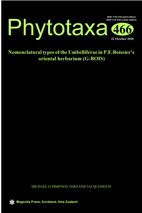Abstract
G-BOIS (“Flora Orientalis Herbarium”), the result of many years (1844–1888) of titanic work by an outstanding botanist from Geneva Pierre-Edmond Boissier, is the most important taxonomic and nomenclature source of data on the rich flora of the territory from Greece to Middle Asia and the borders of India. It was isolated from an extensive Boissier’s private herbarium after the latter was included in the collection of Conservatoire et Jardin Botaniques and kept in a special underground bunker. A material for 366 species and 47 infraspecific taxa of the Umbelliferae is stored in G-BOIS. Among lectotypes, the vast majority relate to the Boissier taxa; a small minority belong to taxa of other authors (their types and lectotypes are in other herbaria). The materials of other herbaria, Geneva and non-Geneva (Geneva General Herbarium, De Candolle Prodromus Herbarium, K, LE, P, JE, W, B and others) were also checked. Among the Umbelliferae material kept in G-BOIS, lectotypes of 255 names were designated here and those of 107 names have been designated before, including lectotypes selected prior 2011 as types and holotypes which were corrected to lectotypes (89 names). Besides the designated lectotypes and isolectotypes, G-BOIS also contains holotypes of 44 Boissierian Umbelliferae names and syntypes of 81 names. Additionally, holotypes, lectotypes and isolectotypes (in total for 168 names) were revealed in Geneva General herbarium (G). One new species name (Prangos iranica nom. nov.) has been proposed here in the genus Prangos.

